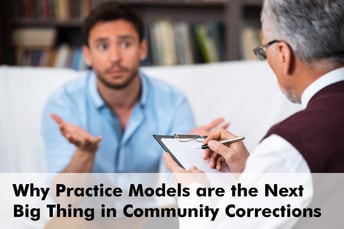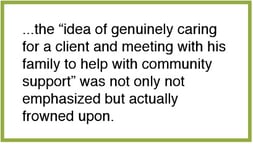
Note from the editor: This blog is a continuation of the EBP Practice Models blog series started by this blog’s author Evan C. Crist, Psy.D. and other industry leading authorities on practice models, Brad Bogue, Matt Moore and Tom O’Connor.
This blog has two parts.
Part I, The Changing Function of a Case Manager, paints a picture of how the role of community corrections practitioners is constantly changing as the field and its stakeholder’s expectations evolve and expand.
Part II, More Effective Treatment, explains the need for a coherent intervention strategy based on logic and research to help case managers do the treatment oriented work we are expecting more and more from them. We suggest Practice Models are the answer to our need for this intervention strategy. Although EBP has been viewed by some as a nuisance, adding more work to already overloaded case managers, read below to see how we think differently.
PART I – The Changing Function of a Case Manager
Case Manager or Psychologist? Or both?
As a participant of community corrections for the better part of two decades, I’ve noticed an interesting and predictable shift in the industry. Yes, it is becoming more treatment oriented, but the change that I find more interesting is the shift to teaching paraprofessionals to deliver specialized services generally allotted for master’s level or doctoral level therapists.
I’ve seen this happen throughout my psychologist career and I don’t think it is good or bad, rather a normal progression of a maturing industry that needs to provide more services to a larger population without the benefit of a significant increase in government funded resources.
But why?
With the advent of newer and better psychiatric medications in the past 25 years, psychiatrists are in greater demand. However, the supply is not keeping up with the demand, so… the hourly rate for their services and expertise goes up! What happens next?
The industry starts to look around for another more available (and usually cheaper) option.
Physician assistants and nurse practitioners have often been used to manage medications, but many do not have the expertise in mental illness to manage complicated psychotic or treatment resistant clients. So psychologists try to fill the gap.
Years ago, psychologist started making the argument that they have the relevant expertise to prescribe and manage psychiatric medications… at a cheaper rate! In fact, at least three states and the Department of Defense now allow appropriately trained psychologist to prescribe psychiatric medications. The experiment appears to have been a success.
Good for psychologists, right?
Psychologists have been on the receiving end of this paradigm shift too. Once, psychologists had a monopoly on standardized psychological testing (IQ testing, Rorschach ink blots, personality assessment, etc.), but, predictably, other professionals see an opportunity to fill the gap between services needed and services provided with more available and less expensive options.
Occupational therapists began expanding their arena of expertise from primarily life and work skills to the assessment of cognitive and psychologist functioning that affects those skills. Similar to the psychologists attempting to expand their terrain, the movement of occupational therapists into more formal, standardized testing has not been absolute but has seen relative success.
A Sign That We’re Maturing
While the professionals losing territory often cry foul for a variety of reasons, such shifts have always occurred and will continue. Any industry that matures sufficiently enough to incorporate specialized services for certain populations will see such a shift eventually. Sometimes intentional and other times an apparently unconscious process, service fields which require the time and attention of people will always find a way to push services to a lower paid professional, and the recipients will welcome the opportunity to prove their expertise and value to the field.
And why does any of this matter?
This phenomenon explains, in part, the momentum that practice models are achieving in all types of community corrections programs, residential and non-residential. Historically, case managers (CM) were trained to check the appropriate boxes, keep an eye on the clients’ level advancement and ensure that drug testing is occurring per oversight agency regulations.
The concept that the therapeutic relationship is not just important but  actually vital to the offender change process is foreign even for experienced CMs. In fact, I’ve had more than one CM explain, as we developed our own practice model, that the “idea of genuinely caring for a client and meeting with his family to help with community support” was not only not emphasized but actually frowned upon. Anything other than dishing out consequences and maintaining compliance with state and federal regulations was essentially seen as a boundary violation.
actually vital to the offender change process is foreign even for experienced CMs. In fact, I’ve had more than one CM explain, as we developed our own practice model, that the “idea of genuinely caring for a client and meeting with his family to help with community support” was not only not emphasized but actually frowned upon. Anything other than dishing out consequences and maintaining compliance with state and federal regulations was essentially seen as a boundary violation.
Some of the old school corrections professionals were taught that any genuine concern for the client might lead to clouded decision-making and open you up as a target for manipulation.
PART II- More Effective Treatment
So, why an EBP Practice model?
Fortunately, science is now being consulted in addition to philosophy and tradition. Evidence Based Principles (EBP) was quick to gather verbal followers but slow to attract behavioral followers. Just when most agencies have “gotten on board,” at least philosophically, the researchers and consultants in community corrections are beginning to preach the importance of a practice model.
I have no doubt that many providers have two questions.
- What the heck is a practice model? (Check out the first blog in this series to help answer that question.)
- I just finished training everyone in EBP, why should I go through the brain damage of this practice model thingy?
As the owner and Executive Director of three community corrections programs, I get it. I really get it. It feels like the target keeps moving. I have clients to manage; I can’t spend the entire day in training three times a week!!!!
We have to hit that moving target
Change is often frustrating, but the pace with which these mandates are coming down from above is particularly tough to swallow.
It feels like the power brokers in community corrections are either chasing the latest fad or delight in watching community corrections staff hair stand on end and eyes cross. While certainly both can be true, the introduction of the practice model is a natural extension of EBP and its time has come.
Why do I say its time has come? First, it is difficult to actually implement all of that EBP stuff you’ve been learning without a tree to hang it all on. A practice model makes it all hang together. Without a coherent decision-making model (i.e., a practice model), you end up looking like one of those mystery prize vending machines.
Randomness determines the prize, not the situation or case formulation. With the EBP information hanging together, you can choose the appropriate interventions based on current client information and struggles, not just the intervention that comes to mind from your last training or the emphasis of the day from your supervisor.
Why now?
So, while the practice model is a logical extension of the EBP movement, there is another reason it is happening now.
As the field moves from accountability based on terms and conditions to it based on behavioral change and objective progress, more resources are needed for trained professionals who understand the change process and have the desire to engage in this messy transition with offenders.
There is a greater demand for therapists who specialize in work with offenders than there is supply. Finding a psychologist to provide an evaluation is not too difficult (but often unnecessary), but finding a therapist who really wants to work with offenders is a different animal.
So…remember the mysterious process that pushes service skills downhill to other providers? It’s here (said like Poltergeist)! With the need for more professionals to engage in the behavioral change process, the field is creating more with EBP training and practice models.
Nobody will say out loud that we are training paraprofessionals to be therapists, but it looks pretty close to me. It started with the excitement about Motivational Interviewing (MI) over 20 years ago. MI is simply a theory and practice of how to help clients convince themselves that change is in their best interest. Looks like a duck. And Cognitive Behavioral skill building (i.e., CBT) is a theory practice and about how humans think, feel and behave. Walks like a duck. The emphasis on the importance of the “working relationship”? Talks like a duck.
More than EBP – It’s YBP (Your Best Practices)
In our desire to become more helpful to clients, we are becoming more flexible and more research based. That is a good thing. It requires the re-education of an entire generation of CMs. That is a good thing, but, no doubt, frustrating to many. Practice models create a coherent intervention strategy based on logic and research. That is a good thing, albeit new thing.
One of my more influential psychology professors explained, “There is more than one way to skin a cat.” Many varied practice models will be innovated. None of them will be 100% complete and all of them will offer some promise. While we obviously want models that assist us in reaching out goal of reducing recidivism, sometimes getting all (or most) of your staff on the same bus and headed in the same direction is the most important first step. Practice models can help with that. THAT is a great thing.
Stay tuned for future blogs on practice models from Evan Crist, Brad Bogue, Matt Moore and Tom O’Connor with topics like:
- What is a practice model?
- Practice Models: Why should I care?
- Practice Models: From Principles to Practice
- Practice Models: How Implementation Science can help
- Practice Models: Develop One in House vs. Installing One “off the shelf”
- Existing Practice Models
- Unfolding a Practice Model Organically: The Building Block Model
- Ramsey County experience
- Time to Change experience
- We have a practice model: Now what?


